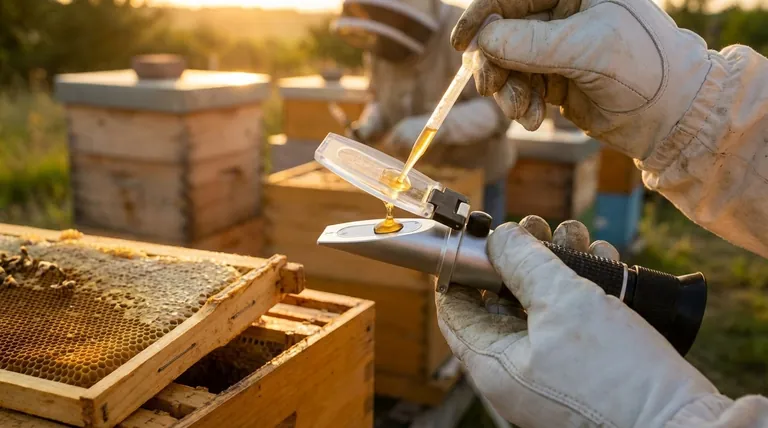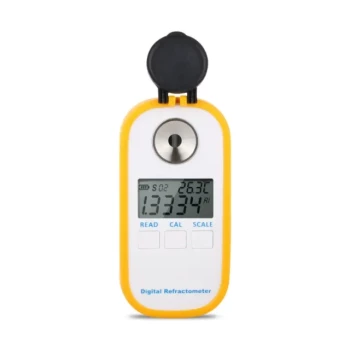The primary benefit of a honey refractometer is its ability to accurately measure the moisture content of honey. This single measurement is crucial for preventing fermentation, ensuring the honey meets legal quality standards, and determining the optimal time for harvest, safeguarding the value and longevity of the final product.
A honey refractometer isn't just a tool for measurement; it's a critical instrument for risk management. By providing a precise reading of water content, it empowers beekeepers and producers to protect their harvest from spoilage and ensure its commercial viability.

Why Moisture Content Governs Honey Quality
The stability and grade of honey are almost entirely dependent on its water content. A refractometer gives you direct control over this essential variable.
Preventing Fermentation and Spoilage
Honey with high moisture content (typically above 20%) creates an environment where naturally occurring osmophilic yeasts can thrive.
These yeasts consume the sugars in the honey, producing alcohol and carbon dioxide, which leads to fermentation. Fermented honey is sour, bubbly, and is considered spoiled or downgraded to "baker's honey," significantly reducing its value.
Ensuring Optimal Viscosity and Flavor
Properly cured honey with low moisture has the thick, viscous texture consumers expect.
Measuring moisture allows you to confirm that the bees have sufficiently dehydrated the nectar, concentrating the sugars and complex flavors that define high-quality honey.
Meeting Legal and Commercial Standards
Most jurisdictions have strict legal standards for honey sold to consumers, often requiring a moisture content below 21%.
Using a refractometer provides the necessary quality control to ensure your product is compliant, marketable, and can be sold at a premium.
How a Refractometer Delivers a Precise Result
While appearing simple, the refractometer uses a reliable optical principle to provide its reading, making it a far more practical tool than complex laboratory equipment.
The Principle of Light Refraction
A refractometer works by measuring the angle at which light bends, or refracts, as it passes through a thin layer of honey.
The concentration of sugar in the honey directly impacts its refractive index. The device's internal scale is calibrated to correlate this angle of refraction directly to the percentage of moisture.
The Critical Role of Temperature Correction (ATC)
Honey's density changes with temperature, which can skew a refractive reading.
Quality refractometers feature Automatic Temperature Compensation (ATC). This mechanism automatically adjusts the reading to a standardized temperature, ensuring you get an accurate, consistent measurement regardless of ambient conditions.
Simplicity Over Complex Lab Methods
Before portable refractometers, testing moisture required expensive and slow methods like isotope ratio mass spectrometry or liquid chromatography.
The refractometer provides an immediate, on-the-spot result with just a single drop of honey, making it an indispensable field and production tool.
Common Pitfalls and Best Practices
The accuracy of your refractometer is only as good as your procedure. Avoiding common mistakes is essential for obtaining reliable data.
The Necessity of Calibration
You must calibrate your refractometer before its first use and periodically thereafter. An uncalibrated instrument will provide consistently incorrect readings.
Most devices are calibrated using a specific calibration fluid or distilled water to set a precise zero point.
Proper Sampling and Application
Use only a small, clean drop of honey. Ensure it completely covers the surface of the prism without overflowing.
Excess honey can trap air bubbles or seep into the device, while too little will result in an inaccurate reading.
The Importance of Consistent Cleaning
After each use, the prism and cover plate must be wiped clean with a soft, damp cloth.
Dried honey residue from a previous test will contaminate your next sample and compromise the accuracy of all future measurements.
Making the Right Choice for Your Goal
Selecting the right refractometer depends on your specific operational scale and goals.
- If your primary focus is hobbyist beekeeping: A durable, analog refractometer with clear optics and confirmed Automatic Temperature Compensation (ATC) is a reliable and cost-effective choice.
- If your primary focus is commercial production: Invest in a digital refractometer for its speed, ease of reading, and high accuracy, considering models with data logging for quality control records.
- If your primary focus is ensuring absolute precision: Choose a model specifically designed for honey with a narrow measurement range, as this often provides higher resolution and accuracy.
Ultimately, a honey refractometer transforms a critical quality indicator from a guess into a known fact, giving you direct control over the integrity of your product.
Summary Table:
| Benefit | Key Function | Outcome |
|---|---|---|
| Prevent Fermentation | Accurately measures moisture content | Stops spoilage, protects harvest value |
| Ensure Legal Compliance | Verifies honey meets quality standards (e.g., <21% moisture) | Marketable product, premium pricing |
| Optimize Harvest Timing | Provides immediate, on-the-spot readings | Confirms proper curing for optimal flavor and texture |
| Guarantee Accuracy | Features Automatic Temperature Compensation (ATC) | Consistent, reliable results in any condition |
Protect Your Honey's Quality and Profitability with the Right Equipment
For commercial apiaries and beekeeping equipment distributors, precise moisture control is non-negotiable. HONESTBEE supplies the durable, high-accuracy refractometers and beekeeping supplies you need to ensure every batch meets the highest standards.
Contact HONESTBEE today to discuss your wholesale needs and secure the tools that safeguard your product's integrity and value.
Visual Guide

Related Products
- Precision Honey Refractometer Instrument for Quality Assessment
- Digital Honey Refractometer for Precision Measurement of Optimal Honey Quality
- HONESTBEE 72 Frame Industrial Electric Honey Extractor for Beekeeping
- 6 Frame Manual Stainless Steel Honey Extractor Beekeeping Equipment
- HONESTBEE 6 Frame Three Use Electric Honey Extractor for Beekeeping
People Also Ask
- Why is a honey refractometer considered essential for commercial beekeepers? Ensure Honey Quality and Profitability
- What is a honey refractometer? The Essential Tool for Perfect Honey Quality
- What is a honey refractometer and what is its purpose? Ensure Honey Quality and Prevent Spoilage
- Why is a honey refractometer essential for honey harvesting? Protect Your Harvest from Spoilage
- What are the key steps to using a honey refractometer? Ensure Honey Quality & Prevent Fermentation



















